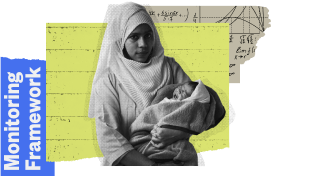
 30,723,210
Total Population
30,723,210
Total Population
A dispute exists between the Governments of Argentina and the United Kingdom of Great Britain and Northern Ireland concerning sovereignty over the Falkland Islands (Malvinas).
The boundaries and names shown and the designations used on this map do not imply official endorsement or acceptance by the United Nations.
Nepal’s Population dynamics Data


Total Fertility Rate (births per woman)
Adolescent (15-19 years) Birth Rate (births per 1,000 girls)
Maternal mortality ratio (per 100,000 live births)
Nepal’s national commitment
As part of its ICPD25 commitments, Nepal has committed to ensuring that marginalized groups, in particularly adolescents and youth, are able to exercise their reproductive rights through universal access to quality family planning services including modern contraception, and the country continues to make progress in fulfilling unmet need and expanding access to modern family planning.
In Nepal, 59% of married or in-union women make decisions on their health care;
while 48% of married or in-union women aged 15-49 years in Nepal make their own decisions regarding sexual and reproductive health and rights, including deciding on their own health care, deciding on the use of contraception, and can say no to sex.
In Nepal, 33% of women aged 20-24 years were married before age 18; 8% of women were married before age 15 and 25% were married between ages 15 and age 18.
The percentage of girls married before age 15 is nearly 1.5 times higher among those living in rural areas compared with those living in urban areas. The percentage of girls married before age 15 is six times higher among those living in the poorest households compared to those living in the wealthiest households, and two times higher for girls married between 15 and 18 years living in the poorest households compared to those living in the wealthiest households.
Nepal has made progress in meeting the sexual and reproductive health needs of adolescents, as seen in the decline in the adolescent birth rate, however it still remains one of the highest among countries in the region.
The adolescent birth rate is higher among those living in rural areas, and is 15 times higher among girls with no education compared to those with higher education, and nearly three times higher among those living in the poorest households compared to those in the wealthiest households.
Nepal’s maternal mortality ratio declined from 2000 to 2017, the year in which it was estimated to be 186 maternal deaths per 100,000 live births.
Recognizing the impact of unsafe abortion on maternal deaths, Nepal is one of 18 countries that have overturned complete bans on abortion, reforming their laws to permit abortion under various circumstances, and is one of 15 countries who have reformed their laws to allow abortion on certain grounds and to ensure Nepalese women’s right to decide on their fertility choices.
In 2019, the proportion of births in Nepal that were attended by skilled health personnel was greater than 75%.
Among married women 15-49 years who had a live birth in the last two years, deliveries assisted by a skilled attendant were higher among women in urban areas, and was lowest among women with no education and among women living in the poorest households. As education and household wealth increases, so does the portion of births attended by skilled health personnel. Among women living in the poorest households, approximately the same percentage of births were attended by auxiliary nursing midwives and by doctors. As household wealth increases, so does the portion of births attended by doctors.
Harnessing the promises of the demographic dividend requires that young people are educated in order to enter the workforce.
Nepal’s literacy rate is higher among men than women regardless of age group. Nepal’s secondary school net attendance ratio is 62, almost halfway between those countries with the lowest and highest rates in the region.
In Nepal, the percentage of youth not in education, employment or training has been increasing in women compared with men, where it is 2.5 times higher as of 2017.
Nepal has some of South Asia’s most progressive laws on the rights of persons of different sexual orientation and gender identity, with landmark reforms passed in 2007 prohibiting gender or sexual orientation discrimination.
In 2013, Nepal issued a third gender category for citizenship documents, and in 2021 determined to include the third gender in the next population census.
Since the Nairobi Summit, high-level national and provincial policy dialogues have taken place, with participation of national and local government, development partners, implementing partners, NGOs, and other stakeholders to discuss inequities in sexual and reproductive health and rights. Youth-led advocacy is also active. National and sub-national youth networks and platforms were mobilized to follow up on youth commitments. An ICPD25 youth coalition alliance with youth-led CSOs was formalized.

















































